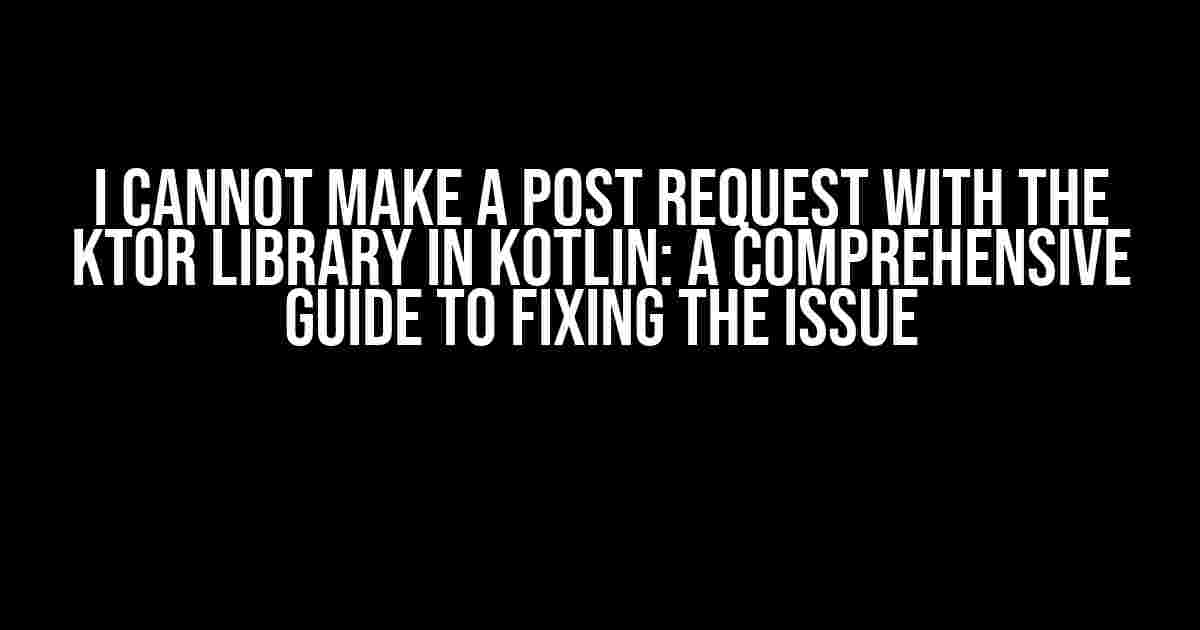Are you struggling to make a POST request using the Ktor library in Kotlin? Don’t worry, you’re not alone! Many developers have faced this issue, and it’s often due to a simple mistake or misunderstanding. In this article, we’ll dive deep into the world of Ktor and explore the common pitfalls that might prevent you from making a successful POST request.
Prerequisites
Before we dive into the solutions, make sure you have the following:
- Kotlin programming language
- Ktor library installed and configured in your project
- A basic understanding of HTTP requests and RESTful APIs
Understanding the Issue
When trying to make a POST request using Ktor, you might encounter errors, such as:
java.lang.IllegalStateException: Request body is emptykotlinx.serialization.SerializationException: Serializer for class 'MyRequest' is not found.Or, you might simply receive a 404 or 500 error response from the server.
Causes of the Issue
The most common causes of this issue are:
- Incorrectly configured Ktor client
- Missing or incorrect serialization configuration
- Invalid request body or JSON serialization
- Incorrect HTTP method or endpoint
Solution 1: Configure the Ktor Client Correctly
To make a successful POST request, you need to configure the Ktor client correctly. Here’s an example of how to do it:
import io.ktor.client.*
import io.ktor.client.engine.apache.*
import io.ktor.client.features.json.*
import io.ktor.client.features.logging.*
import io.ktor.http.*
val client = HttpClient(Apache) {
install(JsonFeature) {
serializer = GsonSerializer()
}
install(Logging) {
level = LogLevel.ALL
}
}
In this example, we’re creating a Ktor client instance with the Apache engine. We’re also installing the JsonFeature with a GsonSerializer, which will help us serialize our request body into JSON. Additionally, we’re installing the Logging feature to log all requests and responses.
Solution 2: Configure Serialization Correctly
Serialization is a crucial step in making a successful POST request. You need to ensure that your request body is correctly serialized into JSON. Here’s an example of how to configure serialization using Kotlinx Serialization:
import kotlinx.serialization.SerialName
import kotlinx.serialization.Serializable
@Serializable
data class MyRequest(@SerialName("name") val name: String, @SerialName("age") val age: Int)
val myRequest = MyRequest("John Doe", 30)
In this example, we’re defining a data class `MyRequest` with two properties: `name` and `age`. We’re using the `@Serializable` annotation to mark the class as serializable, and the `@SerialName` annotation to specify the JSON property names.
Solution 3: Create a Valid Request Body
To make a successful POST request, you need to create a valid request body. Here’s an example of how to do it:
import io.ktor.http.*
import io.ktor.client.request.*
val response = client.post("https://example.com/api/endpoints") {
body = myRequest
contentType(ContentType.Application.Json)
}
In this example, we’re making a POST request to `https://example.com/api/endpoints` with a request body containing an instance of `MyRequest`. We’re setting the `Content-Type` header to `application/json` to indicate that the request body contains JSON data.
Solution 4: Check the HTTP Method and Endpoint
Sometimes, the issue might be due to an incorrect HTTP method or endpoint. Make sure you’re using the correct HTTP method (in this case, POST) and endpoint. Here’s an example of how to check:
val response = client.get("https://example.com/api/endpoints")
if (response.status.value == 405) {
println("Method Not Allowed")
} else if (response.status.value == 404) {
println("Not Found")
}
In this example, we’re making a GET request to the same endpoint and checking the response status. If the status is 405, it means the method is not allowed, and if it’s 404, it means the endpoint is not found.
Common Pitfalls
Here are some common pitfalls to avoid when making a POST request with Ktor:
- Forgetting to install the JsonFeature or Logging feature
- Incorrectly configuring the serializer or deserializer
- Not setting the `Content-Type` header correctly
- Using the wrong HTTP method or endpoint
- Not handling errors and exceptions correctly
Conclusion
Making a POST request with Ktor in Kotlin can be challenging, but by following the solutions and tips provided in this article, you should be able to overcome the common issues and make a successful request. Remember to configure the Ktor client correctly, serialize your request body correctly, create a valid request body, check the HTTP method and endpoint, and avoid common pitfalls. Happy coding!
| Keyword | Description |
|---|---|
| I cannot make a POST request with the Ktor library in Kotlin | This article provides a comprehensive guide to fixing the issue of making a POST request with the Ktor library in Kotlin. |
By following the instructions and explanations provided in this article, you should be able to resolve the issue and make a successful POST request using Ktor in Kotlin.
Here are 5 Questions and Answers about “I cannot make a POST request with the Ktor library in Kotlin”:
Frequently Asked Question
Got stuck with making a POST request using Ktor library in Kotlin? Don’t worry, we’ve got you covered! Here are some frequently asked questions and answers to help you out.
Q: Why is my POST request not working with Ktor?
A: Make sure you have the correct HTTP method set to POST. Double-check your code and ensure that you’ve used the `post` method instead of `get` or any other method.
Q: Do I need to specify the content type for my POST request?
A: Yes, you should specify the content type for your POST request. You can do this by using the `contentType` function and setting it to `Application.Json` or `Application.FormUrlEncoded` depending on the type of data you’re sending.
Q: How do I send data in the request body with Ktor?
A: You can send data in the request body by using the `setBody` function and passing your data object as an argument. Make sure to convert your data to a JSON string or a form-encoded string depending on the content type you specified.
Q: Do I need to add headers to my POST request?
A: It depends on the specific requirements of your API. If your API requires specific headers, such as authentication tokens or API keys, you’ll need to add them to your request using the `header` function.
Q: How can I debug my POST request with Ktor?
A: You can debug your POST request by using the `Logger` feature in Ktor. Enable logging for the `io.ktor.client` package and set the log level to `DEBUG` to see the request and response details.




